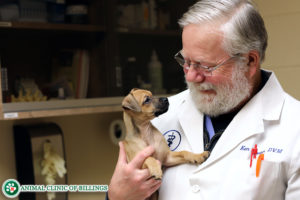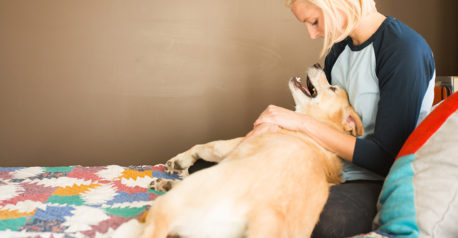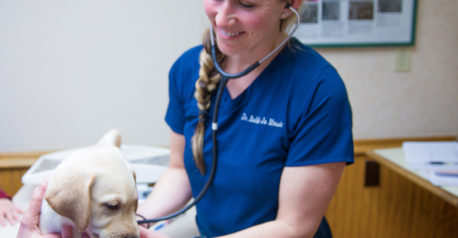Limb amputation
Post-operative Information: Rear limb Amputation
ACTIVITY RESTRICTIONS x 4 weeks
- Please keep your pet in a comfortable, safe indoor location for the next 24 hours until he/she is very steady on his/her feet. Do not allow free access to stairs.
- Your pet may be groggy for the next few days. He or she may whine or appear more anxious than usual; this may indicate pain/discomfort or side-effects of the medications. Please call your veterinarian for assistance with medication adjustments or return for exam and additional pain medications as needed.
- Use a sling under the belly if needed during the first 7-10 days to assist and prevent falling on slippery surfaces.
- Avoid any rigorous activity for 4 weeks. Short, leashed walks are fine.
- Monitor appetite and attitude. If both do not steadily improve over the next 2-3 days, please call your primary care veterinarian or return for progress evaluation and problem-solving.
- You can expect your pet to have a bowel movement within 5 days. He/she may need assistance with posturing to defecate; supporting the rear leg or holding him/her under the belly may be beneficial. Some animals take longer for their first bowel movement depending on when they last ate prior to surgery and when they started eating after surgery. It may be abnormal in color and consistency for 2-3 days. If you have any concerns, please speak with your primary care veterinarian.
- Please confirm that your pet has urinated within 24 hours of returning home. If he/she does not, or you notice any problems related to urination, please speak with your primary care veterinarian.
INCISION CARE
- Please look at the incision on your pet’s hip twice daily. It should be dry, slightly red along the margins, and slightly swollen/thick on the edges. Over several days, it should lose redness and swelling.
- Problems to call your veterinarian about: gapping (the edges should be exactly touching) –discharge (other than small amount of crusting) –swelling (other than slightly raised skin near edges). Some bruising is normal and will resolve in 5-7 days.
PHYSICAL THERAPY REGIMEN
Week 1: Apply ice packs (wrapped in thin cloth) to incision area twice daily for 10-15minutes. Baggies of frozen peas work well for this, or make an ice pack by freezing 2 parts isopropyl alcohol to one part water in a ziplock bag. Continue 7 days to help with pain.
DIET
Ideally, keep your pet on the thin side of normal his/her whole life. Any minor orthopedic condition can progress with arthritis over time with excessive, wear & tear; carrying less body weight will relieve some of this stress on the joints of the remaining 3 limbs. Good parameters to monitor body condition are:
1) you should be able to feel the ribs and pelvic bones, but not see them;
2) your pet should have an “hour glass” figure when viewed from above looking down;
3) your pet should have a tucked up belly when viewed from the side.
PROGRESS EXAMS
Please return to your primary care veterinarian in 10-14 days for a progress exam. Skin healing will be evaluated, sutures (if present) will be removed, and any questions you have will be addressed.
LONG TERM LIFESTYLE
The functional prognosis for dogs treated surgically with amputation is considered good. Following the 4 week recovery period, there are no recommended limitations to their lifestyle.

Let our highly trained and experienced team of veterinarians and veterinary technicians help you keep your cat as happy and healthy as they can be.
Call the Animal Clinic of Billings and Animal Surgery Clinic to schedule your pet cat’s next wellness examination with one of our veterinarians today!
406-252-9499 REQUEST AN APPOINTMENT
ANIMAL CLINIC OF BILLINGS AND ANIMAL SURGERY CLINIC
providing our region’s companion animals and their families what they need and deserve since 1981
1414 10th St. West, Billings MT 59102
406-252-9499



